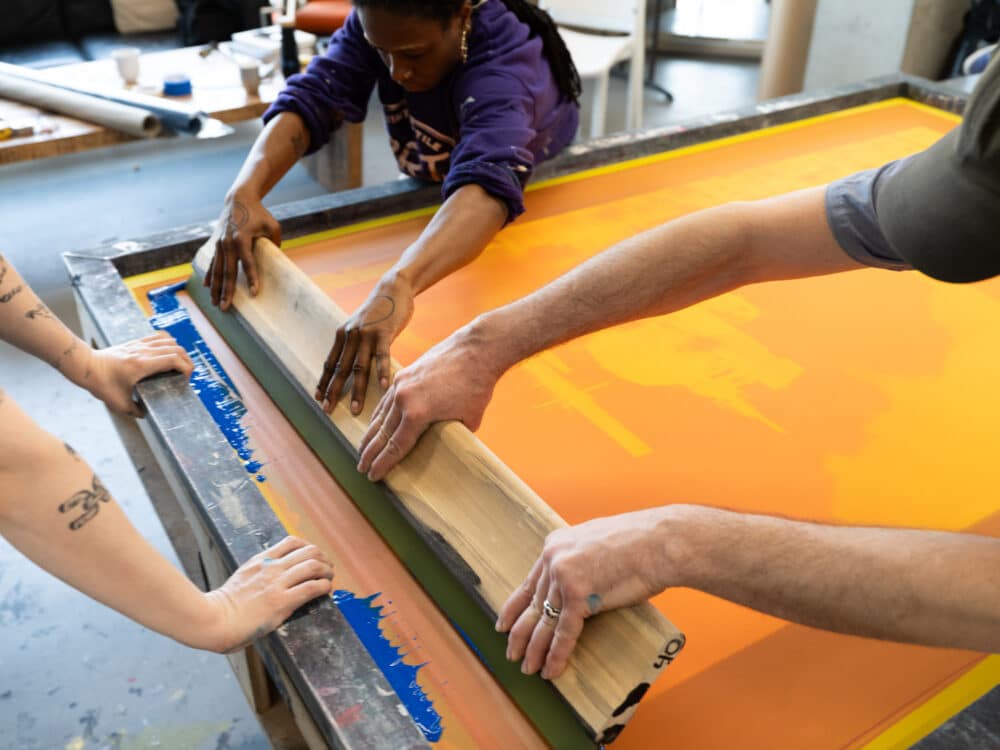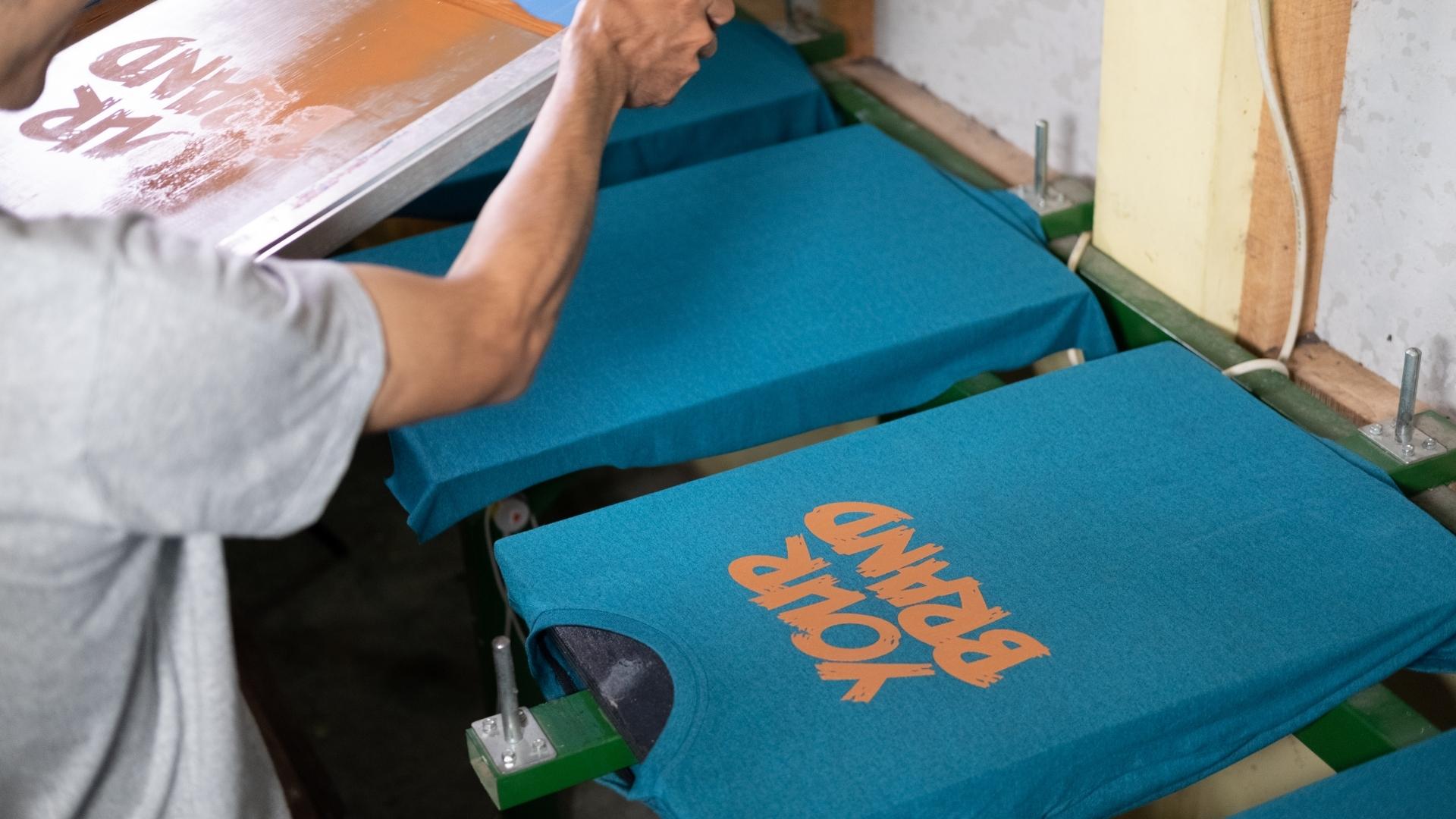From Style to Delivery: Mastering the Art of T-Shirt Screen Printing
The journey from design to distribution in t-shirt screen printing includes a series of critical points that require attention to information and critical planning. It starts with comprehending the nuances of your target market, adhered to by the option of suitable products and the preparation of artwork that meets high requirements. As the procedure unravels, obstacles in high quality control and logistics can occur, potentially influencing the last result. Exploring these complexities exposes not just the ins and outs of screen printing however additionally the essential practices that can raise a brand's standing in an affordable market.
Comprehending T-Shirt Screen Printing
Recognizing T-Shirt screen printing includes acknowledging a functional and commonly used technique for transferring layouts onto material. This method makes use of a pattern and a mesh screen to apply ink onto numerous textile products, mainly cotton and polyester blends. The procedure starts with the creation of a screen that features the desired design, which is then meticulously aligned on the material.
Ink is pressed through the screen's open locations utilizing a squeegee, allowing for specific application of shade. This approach is preferred for its capability to generate vibrant, long-lasting prints that stand up well to washing and use. Furthermore, screen printing is qualified of fitting both basic and complicated designs, making it a preferred choice for customized garments, advertising products, and even imaginative jobs.
Screen printing offers scalability, making it suitable for both tiny batch orders and massive manufacturings. While preliminary setup expenses may be higher contrasted to other printing techniques, the performance and resilience of screen printing typically justify the financial investment. Overall, understanding the basics of Tees screen printing is vital for any individual aiming to engage in this preferred type of textile decoration, whether for commercial ventures or individual tasks.
Conceiving Your Style
Conceiving your style is a crucial action in the T-shirt screen printing process, as it sets the foundation for the entire task (Business Branding Services). This phase involves generating ideas that reverberate with your target audience while making sure that the layout aligns with the brand's identification and message. It is necessary to start by checking out motifs, color design, and graphics that mirror the desired visual
Mapping out preliminary principles can be useful, enabling for a graph of concepts prior to wrapping up the layout. Take into consideration using typography, imagery, and layout in a manner that records interest and interacts efficiently. Furthermore, it is critical to expect the printing method that will be used, as this can affect layout complexity and shade options.
Engaging in brainstorming sessions with group participants or looking for feedback from potential clients can additionally improve the conceptualization procedure, giving varied point of views that refine the design. Ultimately, a well-balanced design not just boosts the visual allure of the T-shirt yet additionally cultivates a connection with the target market, driving passion and potential sales. Therefore, devoting time to conceptualize your layout can result in an effective screen printing end result.
Selecting the Right Products

The weight of the fabric, typically determined in grams per square meter (GSM), influences the drape and overall feeling of the Tees. Much heavier textiles might offer a much more superior appearance, while lighter alternatives fit for laid-back wear. Texture likewise plays a role; smoother fabrics tend to generate sharper prints, while textured surfaces can develop one-of-a-kind visual effects.
Furthermore, take into consideration the environmental impact of materials. Organic cotton and recycled polyester are gaining popularity among eco-conscious consumers. Eventually, picking the best materials involves stabilizing visual charm, capability, and sustainability, making certain that the Tees not only looks great however additionally satisfies the expectations of your target audience.
Preparing Artwork for Printing
Preparing art work for T-shirt screen printing needs mindful focus to detail to ensure that the last print precisely reflects the designated layout. The primary step is to create a high-resolution digital documents, ideally in vector format, as this allows for scalability without loss of high quality. Common software program used for this objective includes Adobe Illustrator and CorelDRAW.
Next, confirm that all text is transformed to details or rasterized to stay clear of font issues during printing (Custom T-Shirt Design & Printing Texas). Additionally, it is important to validate that the color mode is readied to CMYK, as this lines up with the printing procedure. Pay very close attention to shade matching; utilizing Pantone colors can help attain uniformity throughout different prints
Take into consideration the measurements of the print location and preserve appropriate margins to prevent style cutoff. It's additionally smart to consist of enrollment marks for alignment throughout the printing process. Screen Printing. Demand a proof from the printer to picture the last product before mass production. This step is important for recognizing any type of prospective concerns, assuring that the published Tees meets the desired high quality and layout requirements. Appropriate prep work of art work greatly influences the overall success of the screen printing project
Understanding the Printing Process
Mastering the printing procedure is important for achieving top quality lead to Tees screen printing. This stage entails a number of considerable steps that directly affect the end product. The very first step is setting up the printing machine precisely. Proper enrollment of screens guarantees that shades align correctly, preventing misprints and guaranteeing a specialist look.
Next off, selecting the appropriate ink is necessary. Various ink types, such as plastisol or water-based, offer numerous finishes and resilience. Recognizing the textile structure of the Tee shirts likewise aids in picking compatible inks.
Regulating the squeegee pressure and angle is vital when it comes to the actual printing. Regular pressure will yield also ink distribution, while the angle impacts the circulation and coverage. Furthermore, readjusting the speed of the printing machine can affect the ink's healing process, which is fundamental for ensuring longevity.
Quality Assurance and Finishing
After the printing procedure is total, applying effective quality assurance actions becomes vital to verify that each Tee shirts meets the wanted requirements. Quality control involves a methodical approach to checking each garment for defects, validating that the print top quality, color accuracy, and material integrity straighten with the requirements established during the style phase.

The very first step in quality assurance is a detailed visual assessment. This involves monitoring for typical concerns such as imbalance, ink smudges, or fading. Any type of T-shirt that does not satisfy the quality standards need to be addressed quickly, either through reprinting or repair work.
In enhancement to aesthetic checks, it is necessary to conduct laundry tests on a sample of published t shirts to analyze the longevity of the inks and the overall durability of the style. These tests aid verify that the print will certainly preserve its vibrancy and honesty after several laundries, a necessary variable for customer complete satisfaction.
Finishing touches, such as thread trimming and the application of care tags, additionally play a substantial duty in quality assurance - T-Shirt Printing. By concentrating on these aspects, businesses can improve the total discussion of their items, inevitably leading to a much more gratifying client experience
Packaging and Distribution Solutions

To attain optimal packaging, consider using eco-friendly materials that align with sustainability trends, such as recyclable poly bags or naturally degradable boxes. Each Tee shirts need to be neatly folded and positioned in protective covering to avoid creasing and prospective damages during transit. Consisting of a branded insert or care guidelines can additionally customize the experience, promoting client commitment.
Picking a reputable shipping partner is important when it comes to distribution. Review alternatives based on tracking, speed, and cost abilities. Supplying multiple delivery methods can cater to visit the website various consumer requirements, from standard to expedited delivery.
Regularly Asked Concerns
What Are the Common Blunders Beginners Make in Screen Printing?
Typical mistakes newbies make in screen printing include inappropriate screen preparation, inadequate ink mixing, wrong direct exposure times, not enough healing, and overlooking to examine prints. These mistakes can result in inadequate quality and poor lead to final products.
How Can I Avoid Ink From Blood Loss Throughout Printing?
To stop ink bleeding throughout printing, warranty appropriate screen tension, usage suitable emulsion density, pick the ideal ink uniformity, preserve optimal treating temperatures, and avoid overwhelming the screen with excessive ink throughout application.
What Kinds of Inks Are Ideal for Different Fabrics?
Picking inks based on fabric type is essential. Water-based inks are ideal for cotton, giving softness. Plastisol inks fit artificial materials, providing longevity. Discharge inks successfully blend with all-natural fibers, making certain vivid colors without compromising fabric stability.
Exactly how Do I Select the Right Screen Mesh Matter?
Choosing the right screen mesh count relies on the wanted print information and ink type. Abilene T-Shirt Printing Solutions. Greater mesh counts yield better information, while lower matters promote thicker inks. Analyze textile type and layout intricacy for suitable results
Can I Use Screen Printing for Tiny Batch Orders?
Yes, screen printing can be effectively made use of for small set orders. This approach enables top quality outcomes and thorough styles, making it a sensible option for personalized apparel, advertising things, or restricted version runs.
Understanding T-Shirt screen printing entails recognizing a versatile and widely utilized approach for moving designs onto textile. While initial arrangement expenses may be greater contrasted to various other printing methods, the effectiveness and durability of screen printing frequently validate the investment. Preparing artwork for Tees screen printing needs cautious interest to information to guarantee that the final print precisely mirrors the intended layout. Mastering the printing process is necessary for achieving top notch outcomes in Tee shirts screen printing. Common errors beginners make in screen printing consist of inappropriate screen prep work, poor ink blending, incorrect direct exposure times, inadequate healing, and neglecting to test prints.